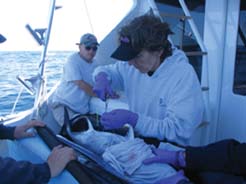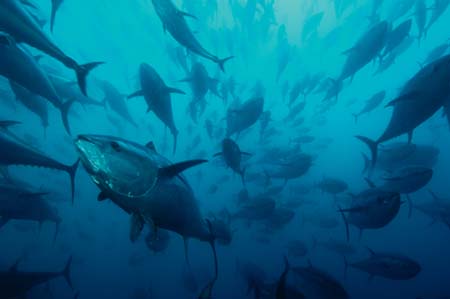 |
 |
| current issue |  | past issues |  | send a letter/news |  | address update |  | advertise |  | about us |  | alumni home |
| Spring 2009 |

|
| Departments |

|
| Alumni News |
| Alumni Profiles |
| Book Reviews |
| Campus Currents |
| Class Notes |
| Features |
| History Page |
| Letters to the Editor |
| Obituaries |
| President's Column |
| Question/Answer |
| University Research |

|
| Department Archives |
| Table of Contents |
|
Search UNH Magazine: |
Features
The Future of FishingPage 2 of 5
Possessed of considerable mega-fauna charisma, the bluefin can cross the Atlantic at the tender age of 2, dive to depths of 3,900 feet, cruise along at 20 miles per hour and crank up its digestion to speed-eat any unexpected bounty it may swim across. It's also regarded as uniquely delicious and is therefore pricey; at Tokyo's Tsukiji fish Market, the record is $173,600 for a single fish.
 
|
| OUTPATIENT SURGERY: Molly Lutcavage implants an archival transmitter into a "tiny," a juvenile bluefin tuna, before releasing it. Research by Lutcavage and colleagues has shown that tuna swim back and forth across the Atlantic, starting at age two. |
At the center, Lutcavage works with faculty, students, fishermen and colleagues from around the world to study the movements and physiology of the large ocean animals that roam the northwest Atlantic. A partnership of UNH and the National Oceanic and Atmospheric Administration, the center develops science and technology that can be used to protect and, when appropriate, harvest the animals. With its high price and extreme wanderlust, the Atlantic bluefin tuna poses a particular challenge.
"The bluefin is pursued by the fishing fleets of many nations, so managing the fishery requires international cooperation," notes Lutcavage. While the International Commission for the Conservation of Atlantic Tuna is supposed to ensure such cooperation, the eastern and western stocks are harvested in completely different ways.
If they are lucky enough to land it, U.S. and Canadian fishermen are allowed only one-twelfth of what their counterparts in the Mediterranean may haul up each year. Westerners must use rod and reel or harpoons. In the East, purse seiners guided by spotter planes and helicopters scoop up hundreds of schooling tuna at a time in drawstring nets. They keep these fish in open-ocean "fattening" pens to improve their commercial quality and avoid flooding the market and driving down the price.
"The justification for such aggressive practices is that there are two stocks—an Atlantic stock in the West and a Mediterranean stock in the East—that were assumed to mix very little," says Lutcavage. "There's a presumed barrier between the two at 45 degrees longitude. The assumption is the eastern stock is larger and can take the added pressure and that the western is failing."
But Gulf of Maine fishermen have claimed for years that their fish routinely swim across the Atlantic. Twelve years ago, Lutcavage began working with fishermen to tag and track the bluefins roaming the northwest Atlantic with a range of old and new technologies.
The center's "Tag a Tiny" program has enlisted the help of more than 300 anglers to attach simple identification tags that can tell about the beginning and end of a juvenile tuna's journey. To help fill in the blanks about what happens in between, Lutcavage's team also tags tuna with surgically implanted archival tags that store information.
Pop-up satellite tags that ride on the tuna's back, capturing information about light, ocean temperature and depth, are the most recent addition to Lutcavage's tagging tool chest. Once the tags pop off and reach the surface, they begin to transmit data via satellite back to Lutcavage's computer. In 2005, she attached pop-up tags to two giant tuna of similar size in the same location off Nova Scotia. The fish were recaptured nearly a year later in almost the same location. In the interval, one had traveled east to Spain's Bay of Biscay, the other to the Gulf of Mexico.
Page: < Prev 1 2 3 4 5 Next >Easy to print version